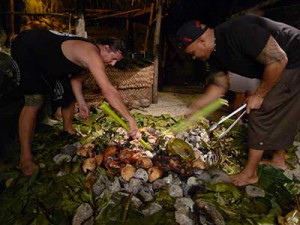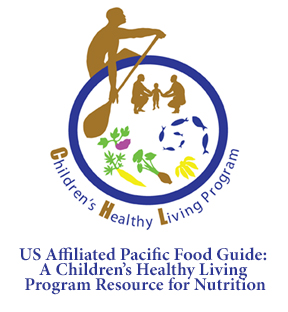Food can be categorized into two dimensions—biological and social. From a biological standpoint, food is essential to our basic survival, and we could simply not live without it. It fuel’s our bodies and gives us the energy we need to live. However, in its social dimension, food has historically played an important role in Pacific Island societies (Pollock, 1992). Food was central to creating and maintaining social relationships. Sharing food with others displayed one’s ability to behave like kin, and taking care of each other through the exchange of food was a highly valued part of building and maintaining familial relationships (McMullin, 2010). This chapter will focus on the social importance of food, rather than its biological importance, across the Pacific Islands associated with the United States.
Sharing
 Food in Pacific Island societies was often shared among family, friends and members of the community. In the Federated States of Micronesia and in the Marshall Islands, food produced by the family was commonly shared among others, even if the amount of food produced was scarce. It was customary for the amount of food given away to be greater than that kept for oneself. The act of sharing was reciprocal, in that families took turns sharing their food with one another. After fishing expeditions, the catch was shared with relatives and friends. If for some reason, such as illness, a man could not go fishing, fish and other foods would be shared with him and his family (Rody, 1982).
Food in Pacific Island societies was often shared among family, friends and members of the community. In the Federated States of Micronesia and in the Marshall Islands, food produced by the family was commonly shared among others, even if the amount of food produced was scarce. It was customary for the amount of food given away to be greater than that kept for oneself. The act of sharing was reciprocal, in that families took turns sharing their food with one another. After fishing expeditions, the catch was shared with relatives and friends. If for some reason, such as illness, a man could not go fishing, fish and other foods would be shared with him and his family (Rody, 1982).
Respect
Food was commonly used in Pacific Island societies to demonstrate signs of respect. In Samoan society, hospitality was shoy status within the village. Chiefs were served first, followed by women, children and the people who prepared the food. Parts of some high status food, such as pig (pua’a), were reserved for different ranks of chiefs. Food servings that were too large for individual consumption were given to the families of chiefs, and the pig (pua’a) or fish (i’a) was passed to individuals based on social status for them to take home after an eating occasion (Bindon, 1988).
In the Federated States of Micronesia, food was also used to convey their respect for others. They often used gifts of food to acknowledge respect for their chiefs and elders in the community. Food was also used to welcome visitors (Rody, 1982).
Social Prestige
In ancient times, the Pohnpeians turned yam growing into a method of gaining social prestige. The man who grew the largest yams and contributed them to feasts attained a high status traditional title. The size of the yams was measured by the number of men required to carry it slung from wooden poles. Average sizes were four to eight man yams, weighing from one to two hundred pounds apiece. This custom still flourishes in Pohnpei today (Rody, 1982).
Festivity
Feasts were an extremely evident part of life across the Pacific, and are still prominent today. Feasts were an important time for households and communities to come together and participate in an event. The food served at feasts was integral to religious ceremonies, life cycle events, changes in status, etc. The entire feast event included both the food preparation and the actual eating of the food itself. Similar to household food events, feasts included a primary starch food and an accompanying dish, but with a much greater variety. The accompaniments could include pork, cooked or raw fish, turtle, seafood, and several mixed dishes such as the Samoan palusami (taro leaves & coconut milk) The distribution of food often took place in accordance with culture specific rules of hierarchy and etiquette (Pollock, 1992).
The largest traditional feast in Pohnpei was called kamatipw, and involved common feast activities: cooking in an earth oven, joint preparation of food, presentation of food to the main guest and communal eating. A kamatipw was held to honor chiefs or other high-ranking persons, with other social events, such as weddings, being celebrated simultaneously. Other feasts celebrated the peak of yam harvest, the beginning and end of house-building and the coronation of chiefs. Yams (kap) and breadfruit (mar) were commonly served, along with kava (sakau) and pig (pwihk) (Pollock, 1992).
Samoans had two main types of feasts: sua and ta’alolo. Sua was a formal presentation that marked the respect for an honored guest. Ta’alolo was a more formal presentation made to a more respected and larger group (Pollock, 1992).
The Hawaiians also had feasts for many occasions. There was a feast for blessing products of craftsmanship. When a skillful piece of work was completed and required the blessing of the spirit guardians (‘aumakua), there was a feast of blessing, dedicating the product to its proper use. This was done for the first items made—a first mat, quilt, fish net, bowl etc. Another event, called the Feast of Countless Hands (‘aha ‘aina laulima), celebrated any communal work that involved the participation of many people. This was specifically related to the tasks of food production: clearing land, making and repairing irrigation ditches, taro patches, fish ponds, or planting large patches of dry taro or sweet potato for ali‘i (chiefs) and maka‘ainana (the people). Feasts of welcome were held to celebrate the return home of relatives or family. Ho‘okipa means hospitality, and comes from the word kipa, meaning to turn in or lodge. The welcoming feast, ‘aha ‘aina, reestablished the returned relative to the ‘ohana and ‘aina, or homeland (Handy & Pukui, 1998).
The main feature of many Pacific Island feasts was that they were occasions for food sharing that brought together different sections of the community to participate in a mutually significant event. Sharing was observed through the contributions made by each household, cooking and the final distribution of the food. Feasts were more than just a food event, but the food in its entirety was extremely important. It was and still is a cultural highlight that marks food as a central symbol (Pollock, 1992).



